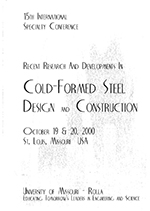Session Dates
19 Oct 2000
Abstract
Cold-formed shapes have been increasingly employed in the construction of small multiple-floored buildings in Brazil, because wide flange shapes required to meet the demand are unavailable on the Brazilian market. Because existing codes fail to cover the design of composite beams constituted of cold-formed shapes, Brazilian design engineers have usually disregarded the contribution of the slab or have adopted improvised calculations that may to lead to unsafe results. The structural behavior of composite beams, constituted of cold-formed double channel shapes and connected to the concrete slab by means of shear connectors that were also cold-formed, was investigated experimentally. Simply supported beams were tested in which the degree of connection (number of connectors) and the type ofload (concentrated or distributed load) were varied. The results were then compared to those obtained through classic theoretical models of composite beam design, which supplied relevant conclusions for the design of these elements.
Department(s)
Civil, Architectural and Environmental Engineering
Research Center/Lab(s)
Wei-Wen Yu Center for Cold-Formed Steel Structures
Meeting Name
15th International Specialty Conference on Cold-Formed Steel Structures
Publisher
University of Missouri--Rolla
Document Version
Final Version
Rights
© 2000 University of Missouri--Rolla, All rights reserved.
Document Type
Article - Conference proceedings
File Type
text
Language
English
Recommended Citation
Malite, Maximiliano; Nimir, Walter A.; de Sales, Jose Jairo; and Goncalves, Roberto Martins, "On the Structural Behavior of Composite Beams Using Cold-formed Shapes" (2000). CCFSS Proceedings of International Specialty Conference on Cold-Formed Steel Structures (1971 - 2018). 2.
https://scholarsmine.mst.edu/isccss/15iccfss/15iccfss-session5/2
On the Structural Behavior of Composite Beams Using Cold-formed Shapes
Cold-formed shapes have been increasingly employed in the construction of small multiple-floored buildings in Brazil, because wide flange shapes required to meet the demand are unavailable on the Brazilian market. Because existing codes fail to cover the design of composite beams constituted of cold-formed shapes, Brazilian design engineers have usually disregarded the contribution of the slab or have adopted improvised calculations that may to lead to unsafe results. The structural behavior of composite beams, constituted of cold-formed double channel shapes and connected to the concrete slab by means of shear connectors that were also cold-formed, was investigated experimentally. Simply supported beams were tested in which the degree of connection (number of connectors) and the type ofload (concentrated or distributed load) were varied. The results were then compared to those obtained through classic theoretical models of composite beam design, which supplied relevant conclusions for the design of these elements.



